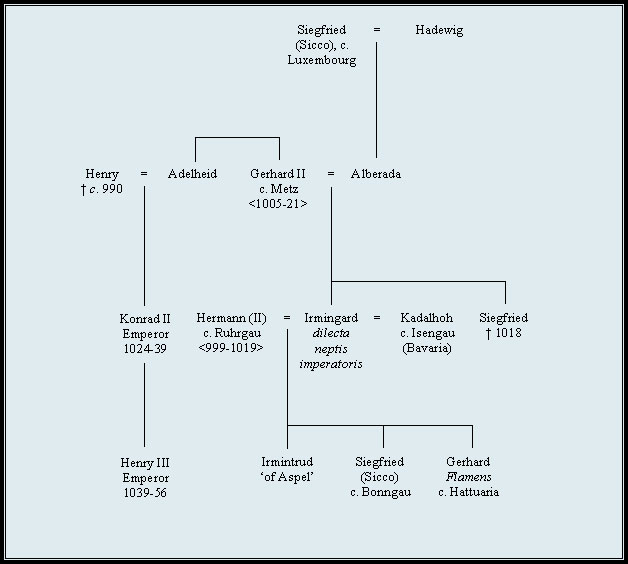|
– THE EZZONEN – (continued)
The successors Sicco (Siegfried) and Gerhard bears names that do not appear previously among the Ezzonen. Rather they recall the Matfridinger onomastic, in particular Gerhard II of Metz and his son Siegfried. This Siegfried, who inherited his name from his mother’s father Siegfried of Luxembourg, was an only son and died without issue. However, he may well have had sisters. We can identify an Ezzoner count who is likely to have married such a sister, namely Hermann (II), who emerges with clarity in 1019 as count of Ruhrgau, a jurisdiction that passed to him from Count Palatine Hermann I, presumably his father. Later it returned to the counts palatine, which suggests the possibility that his sons were underage when he died. Perhaps it was this Hermann who was chosen to ride to Italy to bring the chancellor Heribert news of his election as archbishop of Cologne in 999. As to his wife, there was an Irmingard closely associated with the early history of the collegiate church of Rees, which lay on the right Rhenish bank in the Kleve-Xanten region. Her receipt of an imperial grant of land in 1041 is recorded in an original diploma, found in the Rees archive, yet having no apparent connection with the church’s endowment. King Henry III refers to her as dilecta neptis nostra. Royal diplomata pose an exception to the normal extension of ‘nepos’, where one of the ‘nepotes’ is a grandchild of the common ancestor. Yet the qualification with ‘dilecta’ strongly suggests the intimacy of the normal extension. Since Gerhard II of Metz was Emperor Henry’s great-uncle, the likelihood of a 2:3 link between Irmingard and Emperor Henry III raises the question whether Irmingard was the inferable daughter of Gerhard who married an Ezzoner. Irmingard ‘of Rees’ must be distinguished from an Irmintrud, who also endowed Rees. That these women were very closely related, however, is fully evident from property dispositions. A significant part of the Rees endowment was the territory of Aspel, which the church received from Irmintrud between 1056 and 1075. According to the early eleventh-century chronicle of Alpertus Mettensis, a certain Godizo gave Aspel and the Ripuarian castle of Hengebach to Gerhard II of Metz, who would act as guardian of his wife and daughters. After some vicissitudes, Aspel and Heimbach came to Irmintrud and a certain Count Bruno. Aspel was attached to the church of Rees, while Hengebach became the seat of a seigneurial family. In reconstructing the relationships, historians often fail to appreciate that Gerhard of Metz is well documented as the proprietor before Irmintrud and Count Bruno. Surely it is proper to seek the heirs of Aspel and Hengebach among his descendants, rather than among possible descendants of Godizo’s daughters. These daughters need have had no preeminent right to these properties. Property intersections touching Irmingard of Rees, Irmintrud of Aspel, the ‘non-imperial’ Ezzonen, and the Metz-Luxembourg consanguinity, are genuinely remarkable. They can be pursued almost ad infinitum. The relationships between Irmingard and Irmintrud on the one hand, and Irmintrud and Count Bruno of Hengebach on the other, were especially close. In all likelihood, Irmintrud was the daughter of Irmingard and received from her the church of Rees, which she then gave to the archdiocese. The church of Rees simply passed one step along the line of inheritance before the archdiocese received it. Bruno of Hengebach would appear to be Irmintrud’s son.
[proceed to page 4]
|
